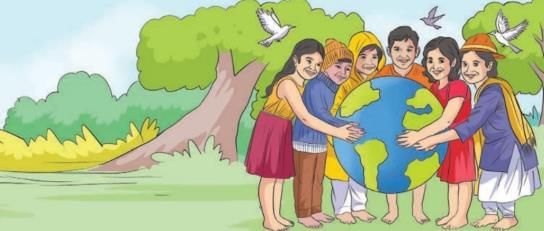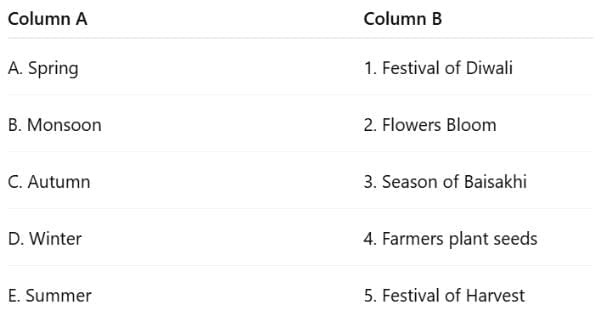Worksheet: Rhythms of Nature | Our Wondrous World Class 5 - New NCERT PDF Download

Q1: Choose the correct option for each question.
(i) What is the name of the place in India known as the ‘First Village of the Sunrise’?
A) Khonoma
B) Dong
C) Thar Desert
D) Arunachal Pradesh
(ii) How many seasons does India have according to the text?
A) Four
B) Five
C) Six
D) Seven
(iii) Which season is associated with the festival of Diwali?
A) Spring
B) Summer
C) Monsoon
D) Autumn
(iv) What activity helps students observe changes in nature throughout the year?
A) Nature Walk
B) Seasons' Journal
C) Drawing
D) Gardening
(v) What do farmers in Odisha associate with the coming of rains?
A) Singing of the koel bird
B) Arrival of monsoon
C) Blooming of flowers
D) Changes in temperature
Q2: Match the items in Column A with the correct descriptions in Column B.

Q3: Fill in the blanks with the correct words from the chapter.
(i) The Earth rotates on its _____, causing day and night.
(ii) The _____ rises in the east and sets in the west.
(iii) In India, the season of _____ is when farmers plant seeds based on the koel's song.
(iv) _____ is celebrated in winter to mark the new year and harvest.
(v) The _____ represents the model of the Earth.
Q4: State whether the following statements are True or False. Correct the false statements.
(i) The sun rises in the west.
(ii) Diwali is a very special festival in India.
(iii) Seasons help us know how plants grow and how animals live.
(iv) There are five seasons recognised in India.
(v) The Thar Desert is known for its high rainfall.
Q5: Answer the following questions in 2-3 sentences each.
(i) What changes did Saba and Aparna notice about themselves and their surroundings?
(ii) How does day change into night and night into day?
(iii) What is the significance of Dong in Arunachal Pradesh?
(iv) How can students observe changes in nature throughout the year?
(v) Why are festivals important in seasons?
Q6: Answer the following questions in 4-6 sentences each. Use examples from the chapter to support your answers.
(i) Explain how day and night occur. What causes this change?
(ii) What are seasons? Name the six seasons of India and explain why seasons are important.
(iii) How do seasons affect human activities? Give examples of food, clothes, and festivals.
(iv) Describe the classroom seasons chart activity. How does it help students understand seasonal changes?
You can find Worksheet Solutions here: Worksheet Solutions: Rhythms of Nature
|
11 videos|211 docs|10 tests
|
FAQs on Worksheet: Rhythms of Nature - Our Wondrous World Class 5 - New NCERT
| 1. What are the main themes explored in "Rhythms of Nature"? |  |
| 2. How do natural rhythms affect the behavior of animals and plants? |  |
| 3. Can you explain the significance of biodiversity in the context of natural rhythms? |  |
| 4. What role do humans play in disrupting natural rhythms? |  |
| 5. How can individuals contribute to preserving natural rhythms and biodiversity? |  |















